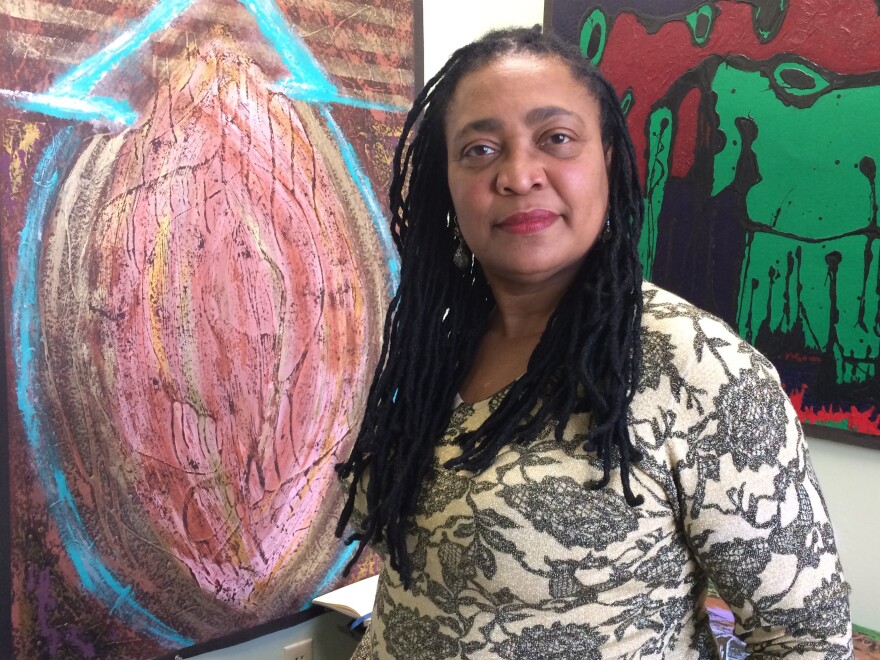In 1967, school board members from a Brooklyn neighborhood were headed to England. They wanted to study how administrators there handled segregation and racial representation in the classroom.
Cleaster Cotton wanted to go too. Officials told her she couldn’t, but Cotton refused to accept that. So, at 12 years old, she got the OK from her mother, nailed down a chaperone and off she went, as her middle school’s student representative. This period of confrontation, between white teachers and black students and parents, became known as the Conflict at Ocean Hill-Brownsville.
“I was very aware of the white power structure, and my mentors were part of the black power structure,” Cotton said. “The DNA that runs through me informs and inspires my work.”
Fifty years after her middle-school activism, it’s impossible to see Cotton’s paintings -- and her life as an artist in Asheville -- outside the context of race and culture. Both show struggle and survival, raw streaks of playfulness and a determination to find brightness in the dark.
“Asheville has all this culture and all this art, but it’s not mine, and so I’ve been malnourished here,” she said. “It’s been the agony and the ecstasy.”
Cotton is part the New Great Migration, of black northerners returning to the south, and some of her art reflects that. Before moving to Asheville seven years ago, Cotton had lived on both coasts and the south, traveled to Africa, raised two children, worked as an executive assistant in corporate America and created a language of shapes and symbols she calls Alnuge.
“The importance in my work has been with what I experienced coming up in Brooklyn, the fact I did make it out alive and helping other children do that,” she said. “That’s what I’ve been doing in Asheville.”

Four of Cotton’s paintings are part of a new group show opening January 4 at Blue Spiral Gallery in Asheville. But they hardly represent the span of Cotton’s personal or artistic path.
She tells of knowing she would become a painter at 5 years old, and of turning to shoe polish and the ink inside felt pens because her parents couldn’t afford paint. She insists her childhood mudpies were culinary art. Through it all, she wrote poetry and often merged her text and images.
“Creating art was not separate from anything,” she said. “It was my life.”
Today, dozens of layered paintings on tarpaper hang or sit in stacks in the studio Cotton just rented inside the Refinery, on downtown’s southwest edge. Many have undercurrents of African and African-American culture. Some are playful and observational to surrounding nature.

As much in Cotton’s color pallet as her brush strokes, there’s a raw, folk art quality Cotton calls “primitive contemporary.”
“(It’s) primitive because my techniques and methodology are inspired by my ancestors,” she said. “I’ve been charged with that energy.”
Randy Shull and Hedy Fischer are Asheville art patrons and gallery owners who were so impressed with Cotton when she arrived in town, they invited her to open their renovated Pink Dog Creative gallery with a solo exhibition.

“Her art at that time was very personal and honest,” Fischer said. “It has an outsider quality to it. It’s just very spontaneous and relevant.”
Fischer remembers Cotton invited black children from the surrounding neighborhood to see the show. She wanted them to see her as a role model—that they could create and show their own art someday.
“Cleaster is a very positive and inclusive person,” Fischer said. “It’s hard to be an art star here. A lot of people would have given up in the seven years she’s been here, but she’s determined to keep trying to be successful with her art, and lo and behold, it looks like it’s coming to fruition for her.”
When asked, Cotton will talk of looking beyond Asheville, to live among more people of color. But she also sees a mission here—for her art, and the spirit behind it, to help others of color know they can find a place in this city.
You’ll find Cotton’s work and that of eight other artists through Feb. 23 at Blue Spiral Gallery’s invitational exhibition.
“I’m completely convinced I can win, and that is the attitude you have to have,” Cotton said. “Whether somebody buys it or not, you will be ok within yourself that you didn’t sell yourself out.”






